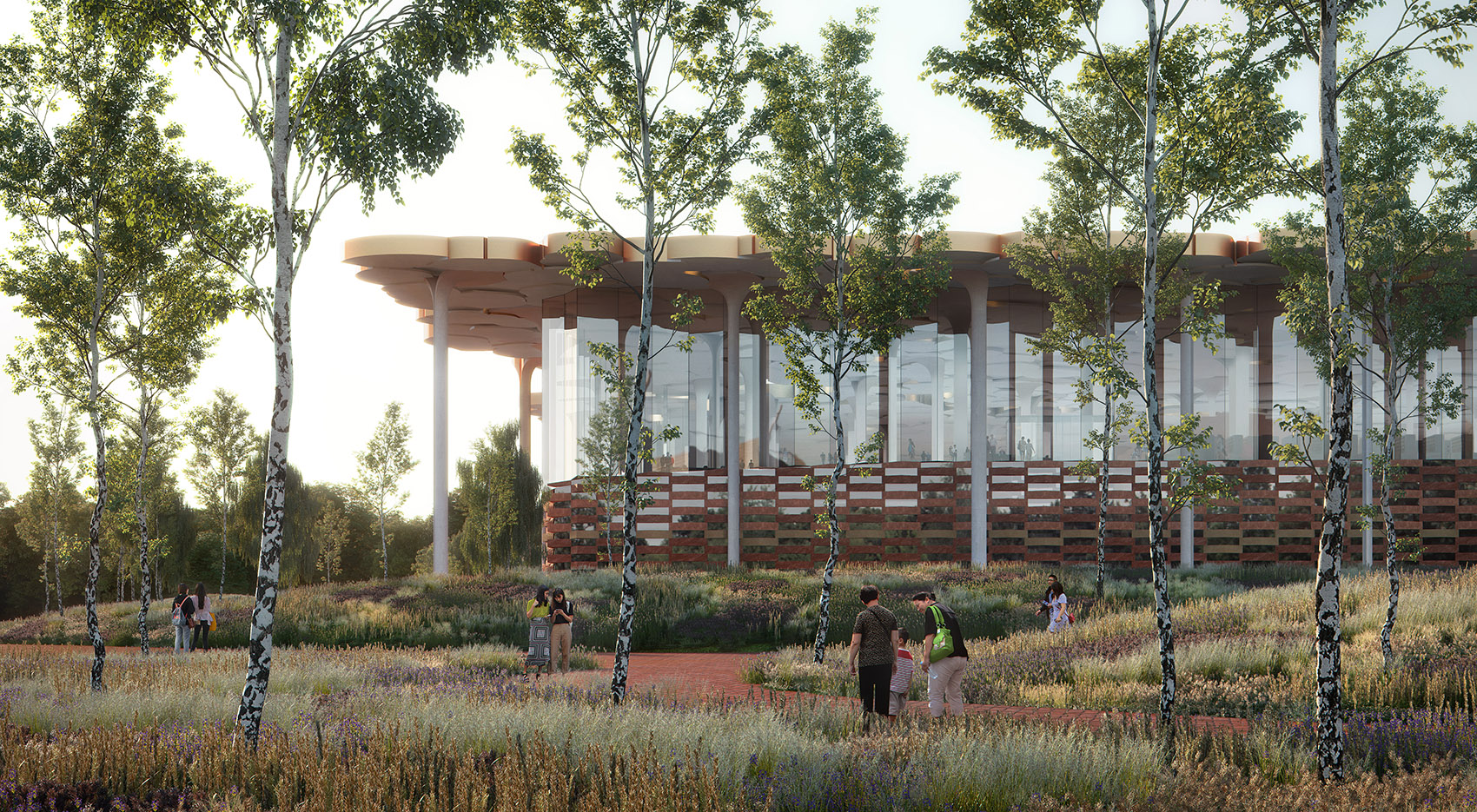全新的北京城市副中心图书馆将于2022年底完工,届时将为人们提供一个既富有当代设计感又能体现出中国传统文化与北京特色的永恒空间,在这里人们可以共同学习、共享知识,沐浴在开放自由的交流氛围中。本项目的设计秉承了可持续发展的理念,力求为图书馆类建筑树立一个全新的可持续标准,通过运用建筑技术、智能设计以及当地资源使本项目从众多图书馆建筑中脱颖而出。
The new Beijing sub-centre library, due to complete by the end of 2022, will offer a contemporary yet timeless space for learning, knowledge sharing and open discussions, as well as celebrating the cultural richness of Beijing and China at large. Aiming to set new standards for sustainable library design, the Beijing sub-centre library will become distinctly different to conventional libraries, utilizing technology, smart design and local resources.
▼项目鸟瞰效果图,aerial view of the project ©Plomp

自2018年赢得国际设计竞赛后,Snøhetta受委托在中国首都设计这座全新的城市副中心图书馆,并在当地合作伙伴华东建筑设计研究院(ECADI)的协助下共同完成了图书馆的建筑、景观、室内整体设计流程。图书馆已于2020年开始施工,目前屋顶结构已经就位,高达16米的玻璃幕墙围护结构则正在安装中。建成后,本项目将成为中国首座超高自承重式玻璃幕墙结构建筑。
Following an international design competition win in 2018, Snøhetta was commissioned to design the new sub-centre library in the Chinese capital and has developed the architectural, landscape, and interior design in partnership with local partner ECADI. Construction started in 2020 and since then, the roof has been put in place and the tall glass enclosure, up to 16 meters, is currently under installation. At completion, this will be China’s first self-supporting glass facade project.
▼入口广场效果图,entrance plaza ©Plomp
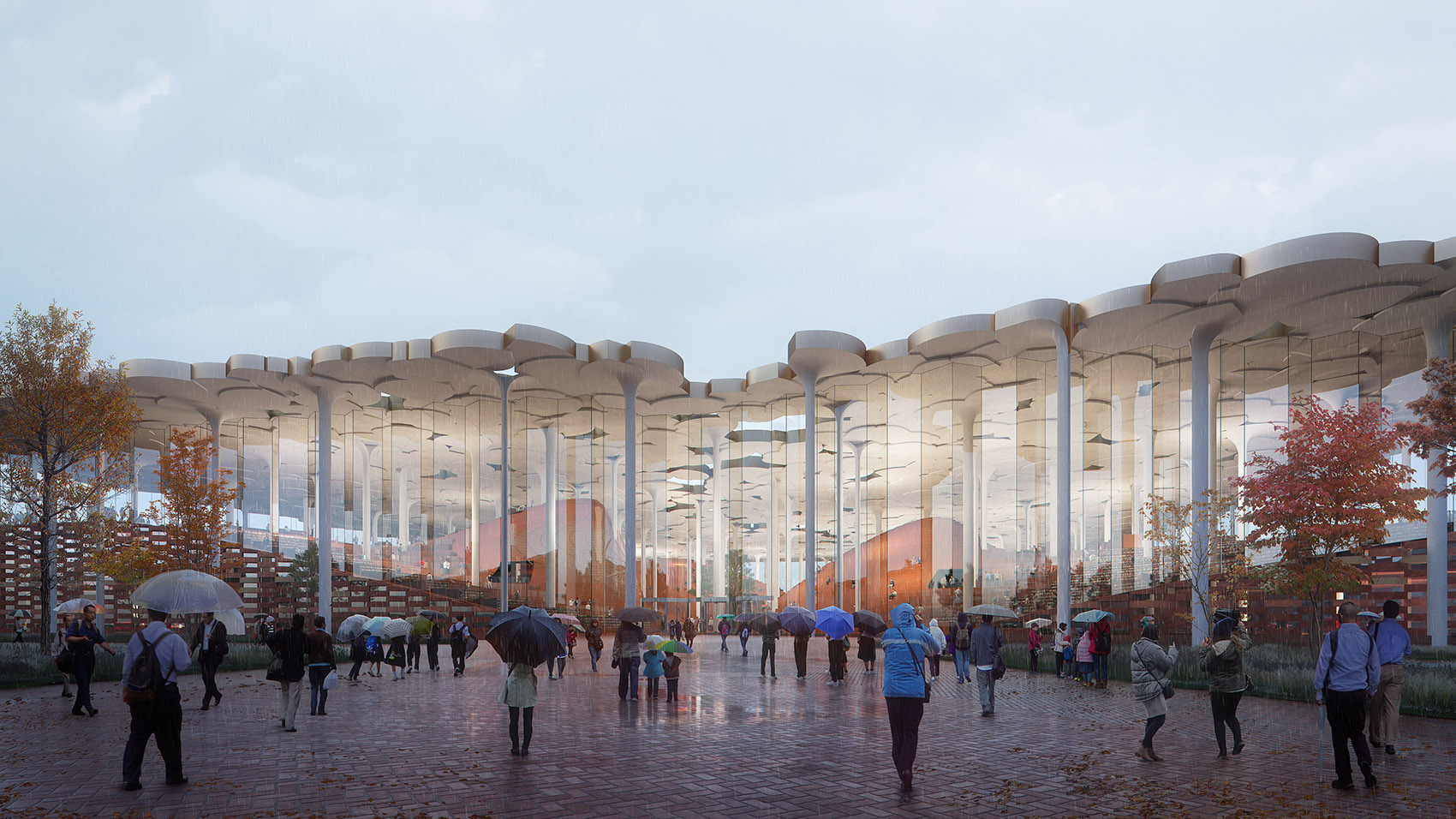
图书馆的设计理念旨在为人们创造一处学习、信息交流和开放讨论的公共空间,同时彰显出北京在科学、艺术、戏曲表演方面的悠久历史与文化传承。为了强调出开放包容的理念,建筑师将公共空间规划在图书馆的中央,层叠错落的台地包含了充足的阅读与藏书空间,宛如一片壮观的雕塑景观覆盖并渗透到整个图书馆空间中。
The library was designed and created to celebrate a public space for learning, information exchange and open discussions, as well as celebrating Beijing’s heritage and rich cultural history of science, art and performance. This has been emphasized by creating a common space as the centre of the library, highlighted by a prominent sculpted learning landscape that covers and permeates throughout the whole library.
▼层叠错落的台地宛如一片壮观的雕塑景观覆盖并渗透到整个图书馆空间中,prominent sculpted learning landscape that covers and permeates throughout the whole library ©Plomp
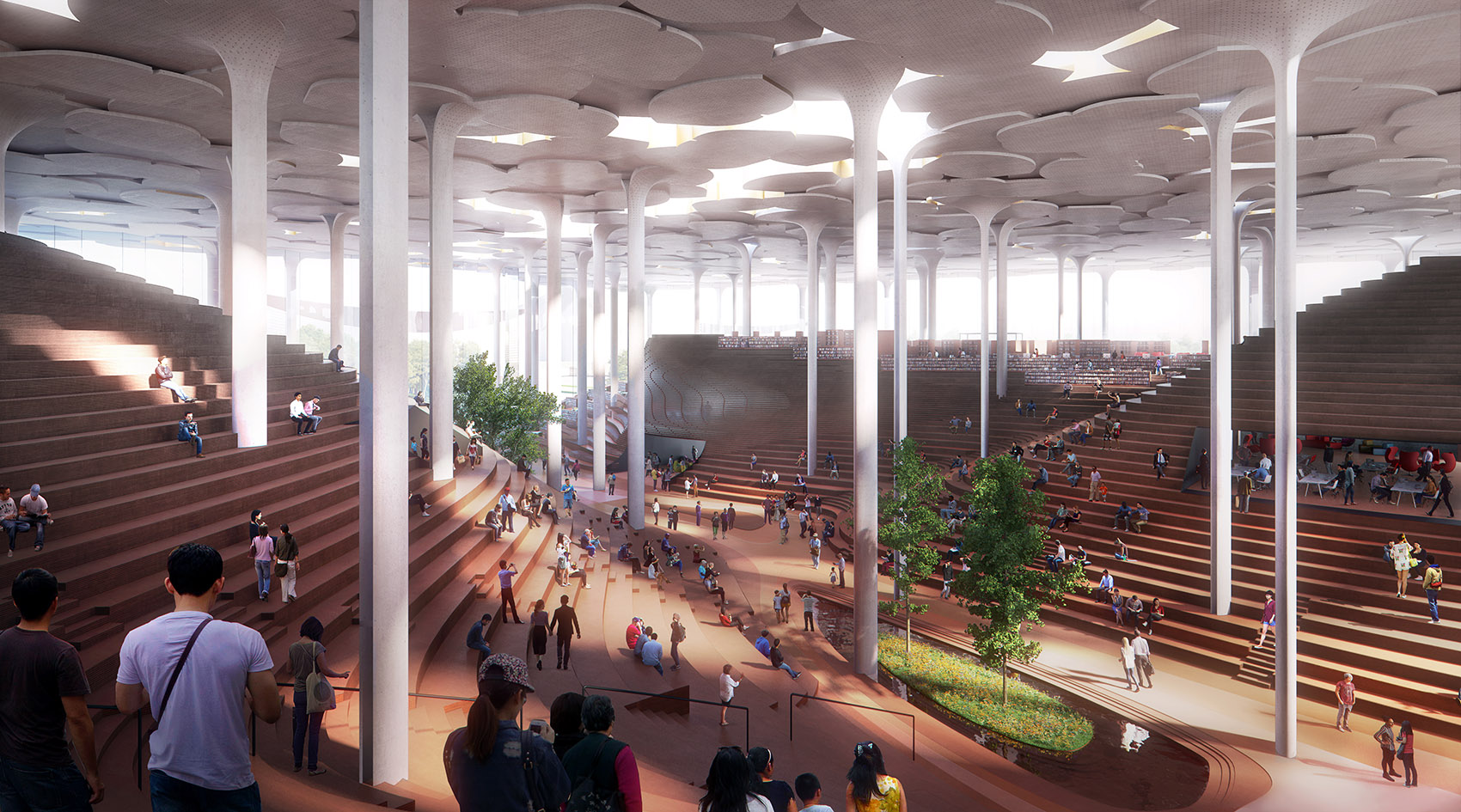
大尺度的开放空间旨在无论是在从空间上还是从心智上都将人们汇聚在一起,大范围的阅读景观促进了知识的传播和获取,并创造出一种与传统图书馆截然不同的空间体验。开放的氛围让所有年龄层的读者们在同一空间中相遇,并在一系列如同剧场一般的圆形空间中展开互动与交流。类似的开放空间分散在整个图书馆的不同位置,旨在促进人与人之间的互动和知识交流。高度透明的建筑立面,将图书馆内部的活动场景悉数展示给城市与路人,邀请着他们进入这个宽敞开放的阅读空间。在建筑内部,位于空间中央的“山谷”形成了图书馆的主体,除了作为建筑北侧到南侧的主要交通空间外,还将台地上所有的阅读与藏书空间与读者们联系在一起。
The big open space of the library is designed to bring people together – spatially but also intellectually: the large reading landscape promotes distribution and access to knowledge and creates an experience that is distinctly different to conventional sections of libraries. This openness gives people of all ages the opportunity to meet on one surface and interact in an amphitheatre-like space. Similar open spaces designed to promote interaction and exchange of knowledge can be found at different locations throughout the whole building. Because of the highly transparent building façade, the library reveals itself and its inner activities to passers-by, inviting them into this generous space. On the inside of the building, the central valley forms the backbone of the library. Besides serving as the main circulation space from the north side of the building to the south side, it links people to all relevant spaces on top of and under the reading landscape.
▼大尺度的开放阅读景观促进了知识的传播和获取,The big open space of the library promotes distribution and access to knowledge ©Plomp
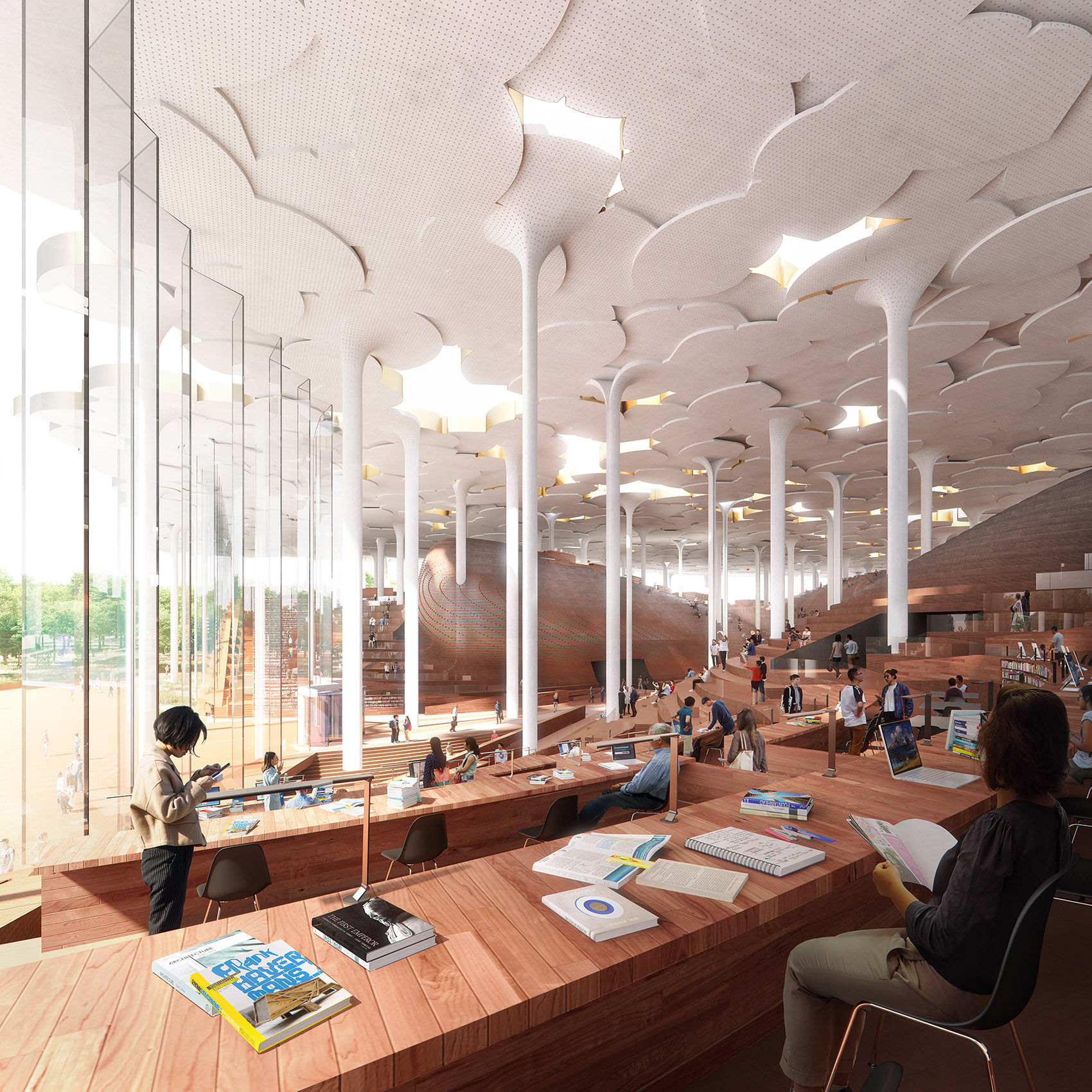
宛如银杏林一般的柱子从“山谷”中拔地而起,“树冠”支撑其巨大的屋顶。每一棵“银杏树”都是建筑技术系统中的重要组成部分,它们共同组成了分布式技术系统,承担了气候控制、照明、声学舒适以及雨水处理的多重功能。阶梯式的景观阅读区与树状的支撑结构营造出舒适的阅读环境与休闲的阅读体验,邀请人们放缓脚步,无论漫步到图书馆的哪一个角落都能够席地而坐,享受着“在树荫下阅读最爱的书籍”的过程。
Extended from the sculpted reading landscape are columns that reach up to support the roof – a ginkgo forest-like canopy. Each tree column is also a building technology component, resulting in a distributed technology system that tackles climate control, lighting, acoustic comfort, and rainwater disposal. The stepped landscape areas with the tree-like surroundings invite people to sit down and take a break at any time on their journey through the building – creating an informal zone and the notion of sitting under a tree reading your favourite book.
▼宛如银杏林一般的柱子从“山谷”中拔地而起,Extended from the sculpted reading landscape are columns that reach up to support the roof ©Plomp
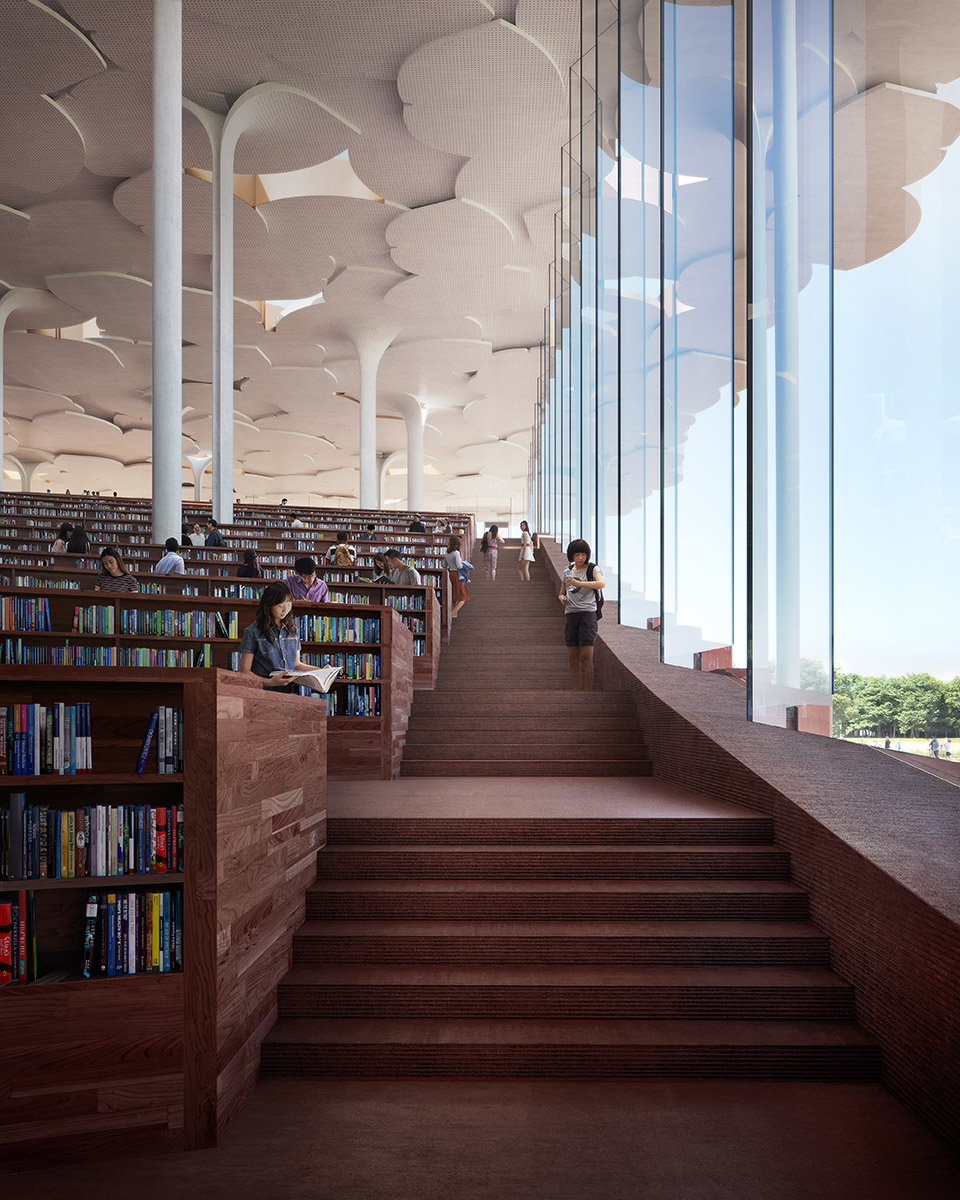
各种各样的体验空间分布在屋顶雨棚与阶梯式的阅读景观之间,在这里游客们既可以寻找到一处只属于自己的阅读与学习角落,同时不失与公共空间的视觉联系。整个图书馆中没有明确的书籍类型或功能部门的分区,而高低错落的阶梯式阅读区则创造出开放与封闭、私人与公共同时并存的空间体验。
Under the roof canopy and atop the sculpted landscape is a variety of experiential spaces where visitors can find their private place for reading and learning while always being connected to the larger common area. Creating a feeling of being tall and low, open and closed, private and public all at the same time. There are no designated “sections” or categorizations of knowledge.
▼高达16米的玻璃幕墙围护结构为室内引入极佳的采光与景观视野,The 16m-high glass curtain wall enclosure provides excellent light and views to the interior ©Plomp
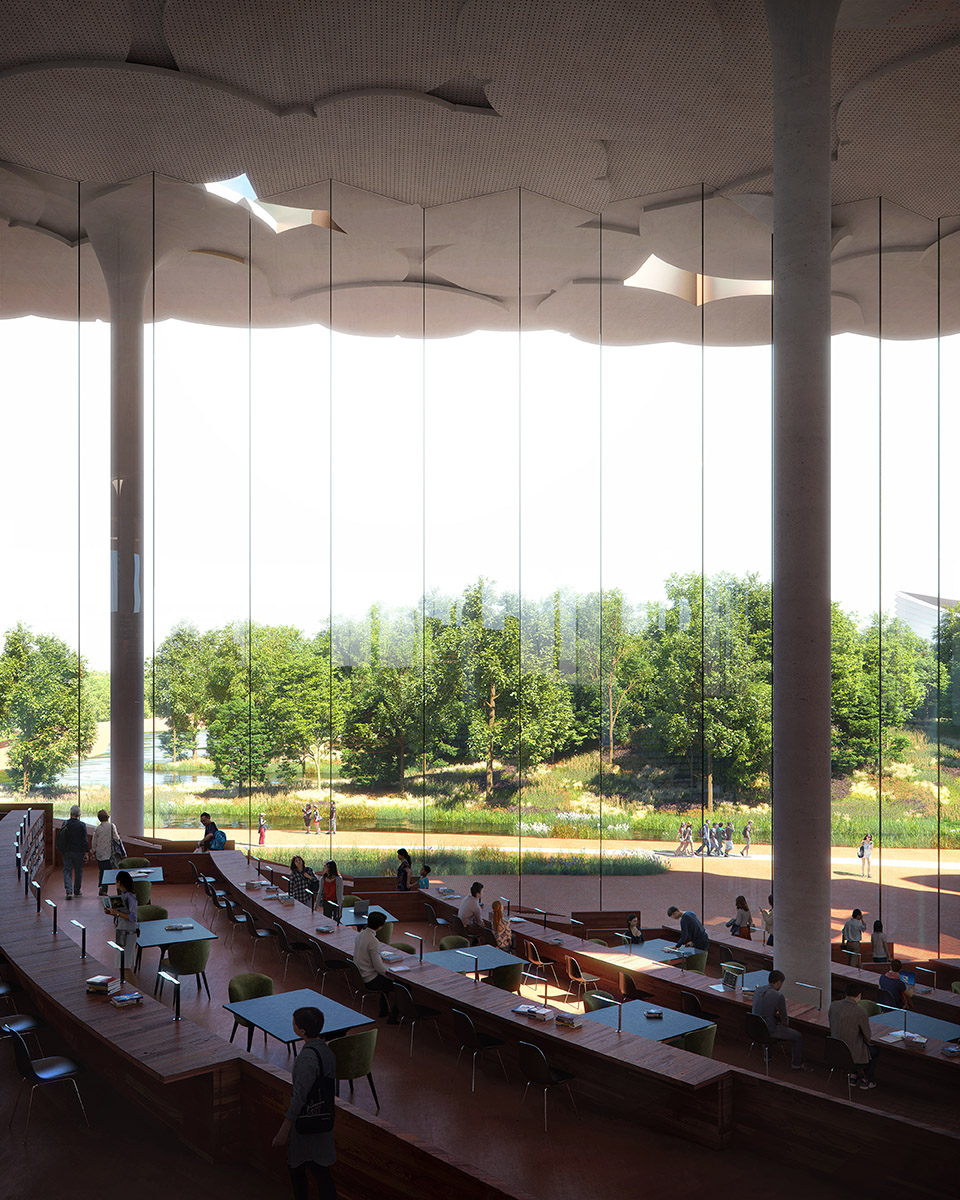
北京副中心图书馆旨在为未来图书馆设计树立一个全新的标杆,从建筑的围护结构技术,到社会和环境的可持续性,再到文化空间的公共所有权,本项目都向大众展示出前所未有的高度。在项目之初,Snøhetta事务所与华东设计院就致力于使副中心图书馆达到建筑可持续发展的最高标准。因此,本项目没有采用传统的屋顶和立面材料,而是在屋顶集成了光伏(BIPV)建筑元素,利用日照产生可再生能源,以到达高度环保的目的。除了作为世界上最环保的屋顶之一,该屋顶结构还具有十分突出的热学性能,能够大幅减少建筑对太阳能的吸收,营造出舒适的室内体感环境。此外,为了进一步优化建筑可持续发展策略,东西侧的玻璃幕墙采取了逐渐降低的设计,而南侧与西侧立面上还增设了主动式遮阳装置,幕墙材质均采用了隔热low-E玻璃。建筑的所有主要材料都来自当地,并采用了模块化组件模式与合理的结构网格,以简化柱子与屋顶结构的定制需求。北京副中心图书馆将于2022年底竣工。
Beijing sub-centre library aims to set a new benchmark for future library design in many aspects – from building and enclosure technology, social and environmental sustainability, to public ownership in cultural spaces. When creating the new Beijing sub-centre Library, Snøhetta and its partners have strived to meet the highest standards possible when it comes to sustainability. The roof has integrated photovoltaic (BIPV) construction elements that replace the conventional roofing and facade materials, utilizing the prime exposure of the rooftop to sunlight for renewable energy production and creating one of the most environmentally friendly roofs possible. The roof also has an overhang to reduce solar gain. The glass height has been reduced on the walls facing east and west, as well as adding an active sun-shading device facing the south and west façade. The glass itself is an insulated glass unit with Low-E- performance. All the major materials for the construction have been sourced locally, and the use of modular components with a rationalized structural grid has been used to reduce the need for customization for both the columns and the roof. The new Beijing sub-centre library is due to be completed by end of 2022.
▼环保生态、高度可持续发展的未来图书馆,A future library that is environmentally friendly and highly sustainable ©Plomp
